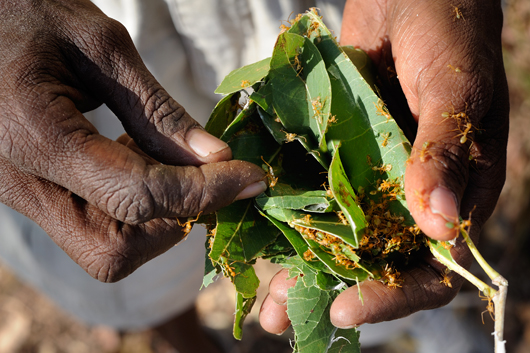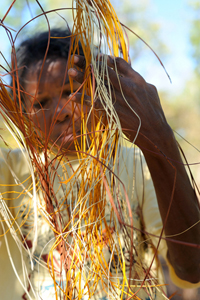A.bc
In Australia, sulle tracce di Chatwin 20 anni dopo Le Vie dei Canti
Palazzo delle Esposizioni, Roma
A.bc
In Australia, in Chatwin's footsteps 20 years after The Songlines Palazzo
Delle Esposizioni, Rome


Violet,
spostando foglie e rami, svela il lato segreto del bush. Racconta come
gli antichi abitanti del luogo hanno usato, nei secoli, ciò che
la natura offre. Spiega le proprietà curative di cespugli e alberi.
Mostra lunghe foglie di palma che si trasformano in stringhe robuste o
collane cerimoniali, canne da zucchero che danno energia per un giorno
intero. Con un gesto abbassa un ramo, a cui è appesa una specie
di sacca fatta di foglie e resina. La strappa via e la schiaccia con le
mani, sfregando velocemente con forza. «Pizzicano, bisogna fare
in fretta». Apre le mani, controlla se sono pronte. «Le formiche
verdi sono buone, sanno di limone, le diamo ai bambini quando hanno male
alla pancia e se le metti in un bicchiere con dell’acqua ti fanno
passare la sete». «Le formiche verdi sono il totem del mio
clan», i Murrumburr. Viene alla mente il film Dove sognano le formiche
verdi di Werner Herzog, girato qui nel 1984. La storia di un ennesimo
incontro-scontro tra cultura bianca e nera, uomo e ambiente. Una compagnia
mineraria vuole scavare in cerca di giacimenti di uranio in una zona ritenuta
sacra, dove per gli aborigeni vanno a sognare le formiche verdi. Ma i
nativi si oppongono: quando le formiche verdi smetteranno di sognare,
per l’uomo non vi sarà più felicità, vuole
la tradizione. Lottano, portano la loro causa davanti alla Corte Suprema,
perdono. Ma il finale è aperto, qualcuno - tra i bianchi della
compagnia - avverte che forse l’antico modo di vivere può
salvaguardare di più l’equilibrio della terra
Violet, shifting leaves and branches, discloses the secret side of the
bush. She tells us how, over the centuries, the ancient inhabitants of
the place have used what nature offers. She explains the healing properties
of bushes and trees. She shows us long palm leaves that can be made into
hard-wearing laces or ceremonial necklaces, sugar canes that give daylong
energy. With a gesture she lowers a branch from which a sort of bag made
of leaves and resin is hanging. She pulls it away and crushes it with
her hands, quickly rubbing it. «You have to be quick or they’ll
sting». She opens her hands to check if they are ready. «Green
ants are very good. They taste like lemon. We give them to our children
when they have belly ache, and if you put them in a glass of water, they
are very refreshing». «Green ants are the totem of my clan,
the Murrumbur». One thinks of Werner Herzog’s movie “Where
the green ants dream”, that was shot here in 1984. The story of
just another meeting-clash between white and black culture, man and nature.
A mining company wants to mine uranium in an area which is considered
sacred and where the Aborigines believe the green ants go dreaming. So
the Natives oppose the project: according to traditional belief, when
the ants stop dreaming, there won’t be any happiness for man any
longer. They fight, they bring their case to the Supreme Court, but they
lose. But there is an open ending. One of the white men in the company
realizes that, maybe, the old lifestyle could preserve the earth equilibrium
better
